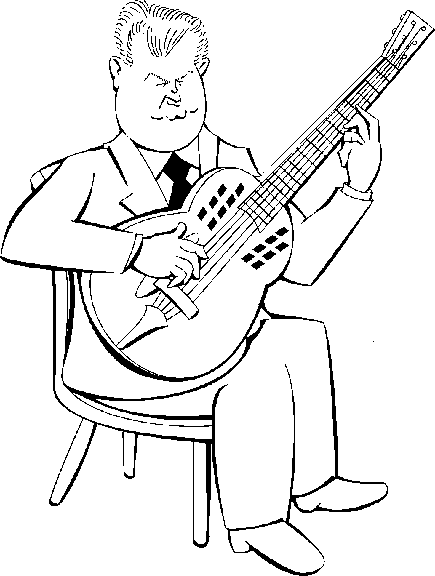Riley Puckett
Booming Voice of the Skillet Lickers
With a Brief Interlude on How to Zoom In and Out on an Image Without Using Scaleable Vector Graphics
Although the Old Time1 musicians known as the Skillet Lickers have been paid a previous tribute, it seems fitting to give a special citation to Riley Puckett who was the guitarist and lead singer. Many - including some of the Skillet Lickers themselves - considered his instrumental and vocal skills crucial to their success.
Footnote
When Old Time - or Old Timey - Music was first so labeled is hard to track down. But the musicians themselves referred to it as such in the 1920's as is documented by the Skillet Lickers themselves in their musical skit "Night in a Blind Tiger".
George Riley Puckett was born on May 7, 1894 but exactly where is a point of scholarly disagreement. One popular informational website puts his birthplace in Paulding County and another in Putnam County about a hundred miles away. And still another source states he was born in Fulton County in the current Atlanta Metropolitan area. But at least everyone agrees that Riley - as he was always called - was born in Georgia.
The usual story is that Riley lost his eyesight as an infant due to a misapplied medical treatment. Whatever the cause, he did attend the Georgia Academy for the Blind where he soon demonstrated his musical talent on the piano. Around 1912, he learned the banjo and later, as we know, the guitar.
Although many visually impaired individuals have led normal lives, this isn't easy even now and was particularly challenging in the early 20th century. For Riley about the only course open was to be what we now call a busker. That is he sat on the street corners playing for pennies, nickels, and the occasional dime.
When Riley began performing good music meant live music. And one of the most popular pastimes was dancing. So it wasn't long before Riley was sought out for the local soirées and he began to enter (and win) guitar competitions at fiddler's conventions.2 But it wasn't an easy life and given the difficulty of travel, Riley stuck close to Atlanta.
Footnote
These music festivals have a long and venerable history and a "convention of fiddlers" was mentioned as if it was a matter of course in South Carolina as early as 1884. "Fiddler's conventions" are broader in scope than the name implies. In addition to performances by individuals and bands, there are often competitions for the fiddles, banjo, and guitars.
The onset of the 20th century was a time of technological revolution comparable to that of the computer and informational age eighty years later. And then as now technology changed the music. In 1906 Reginald Aubrey Fessenden (1866-1932) achieved the first radio transmission of a musical tune. By 1910 a performance from the Metropolitan Opera was broadcast. Then in 1920 the first commercial radio station opened in Pittsburgh, Pennsylvania.
Two years later Riley appeared on Station WSB in Atlanta. By then he was guitarist for the Hometown Band which had been organized by the skilled fiddler Clayton "Mac" McMichen. The station was powerful and could be heard well outside of Georgia and brought Riley to the notice of a wider audience.

Clay McMichen
"Mac"
The next year the band - now the Hometown Boys - began to appear regularly on WSB. Supplementing Mac's playing was the fiddle of Lowe Stokes but it was Riley's voice - which was a strong but smooth baritone - that again caught the listeners' attention.
Not to mention his guitar playing. Riley didn't strum the notes with his hand or a pick. Instead he played individual notes in the manner of a classical guitarist. His technique on the lower strings provided a good bass line and sometimes his accompaniment would include extended sixteenth note runs.
The following year, 1924, Columbia asked another successful fiddler and chicken farmer named Gid Tanner to make some records. In the close knit community of Atlanta musicians, Gid and Riley had known each other for years. So it made sense for Gid to ask Riley to come along. Not only were these the first records of Riley playing and singing but on "Rock All Our Babies to Sleep", Riley gave us the first documented example of country yodeling. A few years later he recorded a quite credible rendering of Jimmy Rodger's "T for Texas" (Blue Yodel #1).
The records sold well (if regionally) and so when one of Columbia's executives, Frank Walker, wanted to make some more "hillbilly" platters, he turned to Gid and Riley as well as Mac for lead fiddle and banjoist Fate Norris. Later the group was supplemented with Lowe Stokes and yet a third fiddle played by Bert Layne. Dubbed the Skillet Lickers, the band was arguably country music's first supergroup. They recorded and performed from 1927 to 1931 and later reassembled in 1934. But by then Riley was not with them.
Instead Riley had branched out on his own. He continued to record with an eventual output of nearly 500 sides. In addition to demonstrating the first yodeling in country music, he also made one of the early recordings of "The Cat Came Back", later covered by Cisco Houston (1918-1961) and then adapted as a folk song for non-folk fans by the New Christie Minstrels in the 1960's.
It's natural to wonder exactly how much the early country performers garnered from their records. Truth to tell, it usually wasn't much. They might receive a lump sum payment for a session, but Janette Carter, the daughter of the famed A. P. and Sara Carter, said her parents, who with Sara's sister, Maybelle, became country music's first superstars, didn't get much in the way of royalties.
Some companies were known to be quite creative in how they disbursed the payments. One producer of folk records, Moses Asch, was quite casual in this regard and often needed a reminder. Dave Van Ronk, one of Moe's artists in the 50's and 60's, would sometimes put on a ragged suit and wait until Moe's office was full. Then he'd stagger in and shout, "Moe! You're not paying me!" Moe would go along with the joke and say "Why, Dave! I'm glad to see you! I was just about to write you a check!" One Grammy winning folk singer became so disgruntled at the lack of imbursement that he quit making records for a decade. There was even one pop singer who had signed with a major label and yet was shoveling coal while his group's song was #1 on the charts.

Moe Asch
Creative
Instead most of the money was from performing. In the later 1930's Riley formed a troupe and began touring in Texas and Oklahoma where the oil industry had boosted the population and its corresponding need for entertainment. But by the start of World War II, Riley had returned to Atlanta where he continued to perform although after 1941 he made no further recordings.
As we've seen details of Riley's life varies with the telling. Not only can no one agree where he was born, but who to and how often he was married and how many children he has remained elusive. So all in all his biographical picture remains a bit murky.
But the picture of Riley that we posted above is scarcely murky. As some who have read previous essays may have guessed, it's rendered using scaleable vector graphics. (And if you want to skip this discussion of vectorized brouhaha, just click here.
Unlike some images posted earlier, Riley's picture is from a separate .svg file formatted from readily available software. As many know, scaleable vector graphics - SVG for short - permits enlarging and "zooming" using only a single image.
But once more we've had the curmudgeons step in! They say that the previous examples of how we use SVG is ignoring

There is, they say, nothing wrong or difficult with zooming in with traditional bitmaps. For instance, the earlier essays imply that only vector graphics can be zoomed with a single image. That, they sneer, is incorrect, and there are times a bitmap is even preferable to achieve the same effect.
Well, if the impression was made that SVG files are infinitely superior to all other image formats and in all cases, then we surely beg your pardon and will make an artist's response to just criticism. On the other hand, what was actually said was that to arbitrarily increase the size of an image - and pardon us if we shout - WITH NO LOSS OF RESOLUTION - this is best done with vector graphics.
Certainly from a practical standpoint it's possible to use traditional bitmaps even if you want to zoom in and out using only a single image. You will, though, have adjust the resolution so you don't get a fuzzy look after you zoom.
For instance, if you use a GIF file for our picture of Riley, then it might very well look OK in the long shot.

Riley
A Long Shot GIF
And the memory requirements for this picture is minuscule - a piddly 12 kilobytes.
Now you can zoom in on the same image. It's easy enough to do. You simply write the following on your webpage:
<center>
<div id="imagePosition" style="height:50%; width:auto; margin-top:2vw; margin-bottom:2vw; overflow:hidden;" ></div>
</center>
<button type="button" onclick="Zoom()" style="align:center;">Zoom 1</button>
<script>
document.getElementById("imagePosition").innerHTML ="<img src='rileypuckett.gif' style='height:100%; transform: translate(0%, 0%);'>";
</script>
<script>
function Zoom()
{
document.getElementById("imagePosition").innerHTML ="<img src='rileypuckett.gif' style='height:205%; transform: translate(10%, 1%);'>";
}
</script>
Although this might look like a bunch of mumbo-jumbo, what's important is the way the <div> and <img> elements are formatted.
First the <div> is set at convenient dimensions - here it's 50% of the window height (the width is simply set to "auto"). The format of the <img> element is to set the width and height both at 100%. This allows the image to occupy the entire area allocated by the <div>. The "transform" function lets the image move up and down and left and right and is important when deciding where you want to zoom in.
What's most important is to have the overflow set to "hidden". If you don't hide the picture's overflow, that is, the parts outside the <div>, you just get a bigger but unclipped picture which can overlap with other features on the webpage (even the text).
You can of course use absolute units like pixels instead of percents. But the picture will keep the same absolute size even if you resize the window. You usually will also want to avoid using position: absolute even though you'll sometimes read this is good for cropping an image. That will keep the picture at the same place no matter what else is on the page and often makes a mess.
The Zoom() function is, of course, what makes the image zoom in. It's controlled by the button where the onclick="Zoom()" activates - that is, "calls" - the Javascript function that does the zooming. What the function does is simply expand the display area of the image but because the <div> hides the parts that go its boundaries, you get an enlarged and cropped picture.
So with the button, the CSS format, and the zooming function, the code will insert the picture of Riley rom the file "rilypuckett.gif" on the webpage where the <div> element is placed. Clicking the button zooms in.3
Footnote
As a caution for the complete beginners, they have to make sure that the image's file - here rielypuckett.svg - is in the same directory as the file with webpage code. If the file is stored elsewhere the code has to provide the proper path to the file.
You can, of course, add more buttons which link to extra functions. So by twiddling with the image height and width numbers and making sure the Zoom functions and the imagePosition elements are given distinct names for separate displays on the same page, you can zoom in and out as much and as often as you please.
But here's the caveat for the curmudgeons. If you use a GIF file that's too small, it may look fine at first. But if you zoom in you will indeed get a grainy look that gets worse as you zoom in more. This is evident if you click on the buttons below:
Riley
Zoomable GIF
Of course, if you use an .svg file, the problem vanishes. But if we want to stick with a GIF all you have to do is boost the GIF up in size - here up to about 30 kilobytes - then everything will still look fine.
Riley
Zoomable Large GIF
See! the curmudgeons smirk. You really can't tell the difference between the SVG and GIF files! You didn't need all that excursion into scalable vector graphics. Just a good old GIF file will do the job fine, thank you.
Well, perhaps, but look at and click on this:
Riley
Super Zoomable Large GIF
This, of course, was using the 30 kilobyte GIF file. But now we do the same on:
Riley
Super Zoomable SVG
... which is from the SVG file. And let's go a step further:
Riley
Super Super Zoomable SVG
... and to compare with the GIF file equally zoomed:
Riley
Super Super Zoomable Large GIF
So in answer to the curmudgeons, the zooming is indeed open-ended using the SVG file, but there's clear limits on the GIF. Of course, you can go to using a larger GIF file but eventually it's memory would end up having to be larger than the SVG.
We hope everything has been settled.
(To return to the start of the SVG discussion, click here.)
During World War II, Riley remained in Georgia largely playing around Atlanta. Country music still had a large market, but its nature was changing. Of course, today country music practically controls the national economy. But in Riley's time, the music wasn't country. It was "hillbilly".
But despite the name, the singers appeared to be scarcely that. In the 1920's and before, the musicians looked like they were in church. The men would put on their best suits and ties and the women would don proper and decorous dresses.
But in the 1930's came the rise of radio shows which would send cast members on national tours. So as not to disappoint their urban audiences, the men began sporting bib overalls and floppy hats and the women had their gingham dresses and pigtails. These "hillbillies" largely played the Old Time Music.
But by the 30's there began appearing other groups where the performers came on stage decked out in cowboy hats and boots and well-pressed fancy suits. These cowboy-dudded players sounded different. The fiddles played a smooth tranquil backing while up-tempo tunes began to have a decided swing to them. Here and there the new-fangled - and electric - steel guitar began to creep in.
But one of the biggest changes was the men. Instead of straining for high and nasal vocal tones, they began singing with pleasant and melodious timbres. And it would be some time - into the 1960's - that the vigorous descendent of Old Time Music - known as Bluegrass - would become nationally popular.
The irony is that with his mellow baritone and expert guitar playing Riley very well may have fit in with the new Country and Western Music.
But although Riley sometimes later exchanged his suit for more Western attire, he never got a chance to join the Grand Old Opry. In July 1946 he developed a skin infection on his neck. Today this would have required only minor medical attention. But in the pre-antibiotic days even minor cuts could lead to bacteremia (then called blood poisoning) which could worsen to acute sepsis. This is what happened and Riley soon died, 52 years old.
References
"Riley Puckett", Wayne Daniel, New Georgia Encyclopedia, May 9, 2003 (Revised July 16, 2018).
"Riley Puckett", Hillbilly Music Source and Symbol.
Definitive Country: The Ultimate Encyclopedia of Country Music and Its Performers, Barry McCloud and Contributing Writers Ivan Tribe, Charles Wolfe, James Elliott, William McNeil, Janet Bird, Lesley-Anne Peake, Steven Morewood, Dale Vinicur, Steve Eng, and Bonnie Bucy, Perigee, Berkeley Publishing Group, 1995.
"Riley Puckett"
"Gid Tanner/The Skillet Lickers"
"What is Old Time Music?", Mark Humphrey, Reprinted on The Old Time Music Home Page.
"The Men on the Ticket", The Abbeville [South Carolina] Messenger, October 1, 1884.
"Milestones: First Wireless Radio Broadcast by Reginald A. Fessenden, 1906", Engineering and Technology History Wiki.
"History of Commercial Radio", Federal Communications Commission.
Country Music Records: The Legends and the Lost, Tony Russell, Oxford University Press, 2007, 2010.
"Gid Tanner and His Skillet Lickers", Wayne Daniel, New Georgia Encyclopedia, May 23, 2003 (Revised July 16, 2018).
"The Skillet Lickers: A Study of a Hillbilly String Band and Its Repertoire", Norman Cohen, The Journal of American Folklore, American Folklore Society, Vol. 78, No. 309, (Hillbilly Issue), July-September, 1965, pp. 229-244.
They Heard Georgia Singing, Zell Miller, Mercer University Press, 1996.
"Lowe Stokes at Brandywine", Joe LaRose, Recorders Collective.
"Interview with Clayton McMichen, 1959", Fred Hoeptner Collection, Southern Folklife Collection, University of North Carolina Libraries, 1959.
"Riley Puckett: Rock Our Babies to Sleep", Internet Archive.
"Riley Puckett", Discography of American Historical Recordings, University of California - Santa Barbara.
"Riley Puckett", Discos.
"Skillet Lickers", Discography of American Historical Recordings, University of California - Santa Barbara.
"Gid Tanner and The Skillet Lickers", Bluegrass Messengers, Richard Matteson.
"Riley Puckett"
"Gid Tanner"
"Clay McMichen"
"Lowe Stokes"
"Bert Layne"
"Fate Norris"
"Night in a Blind Tiger", The Skillet Lickers – Old Time Fiddle Tunes And Songs From North Georgia, Volume 2, County Records, 1973
"George Riley Puckett", Find-a-Grave, September 18, 2009.
"Blanche H. Bailey", Find-a-Grave, September 7, 2009.
"Seven Ways to Compute the Relative Value of a U.S. Dollar Amount - 1790 to Present", Measuring Worth.